Girls with butter eyes, flowers tossed at their feet, matzevot with silver eagles, shiny shoes and impeccable uniforms. Throw in the rifles with bayonets shining in the sun, a song on the lips and we already have the image of the marching First Cadre Company. Only it has nothing to do with reality!
Let's agree, the old woman, Europe, on the eve of the outbreak of the First World War, was sitting on a powder keg and sooner or later the conflict had to break out. Shots are fired in Sarajevo, and then everything is in an avalanche.
They declare war on the other and quickly threatening with a saber on both sides turns into a world conflict that naturally reaches the Vistula River as well. Let's not forget that the Polish lands lie within the borders of the partitioning powers, and it all began with one of them - Austria.
In any case, a group of patriotic madmen gathers in Krakow, headed by a certain Piłsudski (known to the authorities as the old troublemaker), who think they will revive Poland. They gather around them young people who have been operating within the framework of Polish military organizations and form them a "forge of cadres" for the future Polish army, known as the First Cadre Company.
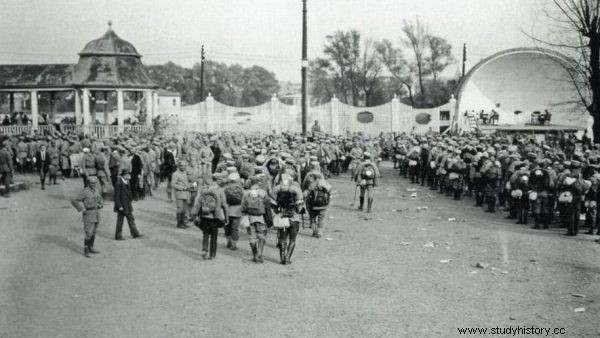
Concentration of shooters in Krakow's Oleandry in August 1914.
Piłsudski has a great idea in his heart and a great void at the box office. Compared to the commanders of other nations, it has woefully few resources.
The Austrians marked the Kielce region as the area of operations for him and equipped his people not as soldiers, but as intelligence-subversive militias, giving obsolete weapons and refusing machine guns and cannons . It couldn't have ended well.
Cavalry patrol on foot
Before Kadrówka even left Oleandry, Piłsudski sent a reconnaissance to Jędrzejów. It was the so-called "Belina Seven", i.e. seven volunteers from "Strzelce" under the command of Władysław Belina-Prażmowski.
They set off on their patrol, which was in practice the first military actions of Polish military formations in the world war, in two carriages. Not very cavalry, but there just weren't any horses for them. They had to either commandeer them or… steal them. Even allied troops.
The Austrians did not provide them with adequate supplies, so the soldiers were also forced to seize food, forage and other necessary things from the local peasants.
The situation was so bizarre that even when Polish riders captured the horses, it ... only worsened their situation.
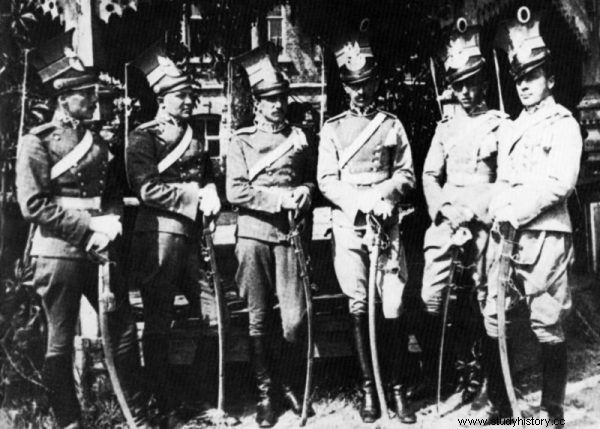
Belina's seven without a single companion, who died in battle. First from the left is Ludwik Skrzyński "Kmicic".
They did not have (yet) uhlan condition and endurance, which is perfectly evidenced by the case of Ludwik Skrzyński pseud. Kmicic. He felt so well in the saddle that he was transferred to the infantry because of ... chafing from riding in a place where the back loses its noble name.
The reconnaissance resembling a comedy of errors was only the beginning of a great adventure, about which textbooks are silent today.
Zbieranin Piłsudskiego
On August 5, 1914, Piłsudski receives permission from the Austrians to cross the border with Russia and take action in the Kielce region. The next day, Austria-Hungary begins the war with Russia, and at 3.30 am, the shooters march from Krakow towards Kielce. Pathos, patriotism and hope. This is what it looks like in all the chronicles, but from the perspective of an ordinary soldier it was completely different.
The training of volunteers that Piłsudski had at his disposal was various. In addition to the old team players, the ranks of the shooters included many green and young as spring grass volunteers. They had to be trained quickly and prepared for the march.
Sagittarius look more like a shapeless jumble than real military. Those who have shooting uniforms still look good. The rest looks different. Often the only element of the outfit that suggests belonging to the military is an inconspicuous maciejówka with an eagle.
The equipment of individual shooters also does not look impressive. Whoever has what he has on his back - some military satchels, others ordinary backpacks. Let their own words be used as a comment on the condition of the shooters' uniforms:
Although there are holes in the shoes and the pants of the patches
This is the First Personnel going to the cannons.
Ref.
Oj da, oj da dana, Kompanio dear,
You don't have it like the First, no!
It is not appropriate to argue, since, as General Marian Kukiel claimed, the song was gradually formed in the march, nameless poets added stanza after stanza ("Polish News" 1915).
Rifle on a string, cartridges in pocket
Riflemen are armed with Werndle, old single-shot rifles withdrawn from the Austrian army. Of course, they don't get the right belts for them, so they have to manage somehow. And although there are anecdotes about the Red Army that its soldiers carried rifles on strings, Piłsudski's Legions were not any better at the beginning.
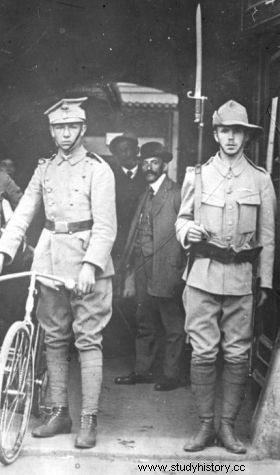
Whether you stand or lie down, you deserve a military drill! A shooting guard in front of the recruiting office of the Polish Legions in Krakow (1914).
The shooters, due to the lack of belts, carried their weapons on strings, and without pouches, they stuffed the cartridges into their pockets or backpacks and ... they lost them frequently. Let's give the floor to a seventeen-year-old shooter:
Not having pouches, or so-called patrontash in Austrian, I put 10 rounds in the bottom right and left pockets of my shirt with the entire packaging, just in case by hand, I put the rest in a backpack between my underwear.
As these are lead cartridges and their caliber is quite large, the weight is quite significant. Too bad, I wanted a war, so I have to bear it. […]
While getting dressed, I noticed holes in the bottom side pockets of my sweatshirt and a few cartridges missing. I decided to be a good soldier, and in the meantime, in spite of anger, I lose my cartridges (W. Wilczyński, "On the combat trail with the 1st Brigade of the Polish Legions. The Diary of Wilhelm Wilczyński", Warsaw-Bełchatów 2012).
Legions are a soldier's note and a very tiring thing!
Young shooters, untrained in marches and unaccustomed to inconveniences, endured the march hard. Already a few hours after setting off, they couldn't feel their legs. Despite the fact that the commanders methodically managed the same break every bit during the trip, the rests seemed to be shorter and shorter with each successive kilometer, and the sections to be covered were still longer and longer.
Even the coffee cooked in a cauldron set on bricks and the bread received for breakfast are not very uplifting. Anyway, the field kitchen does not exist as such, so soldiers sometimes march fasting all day long. Even when they reach the place of accommodation, they also do not get to eat right away. Dinners still have to be cooked.
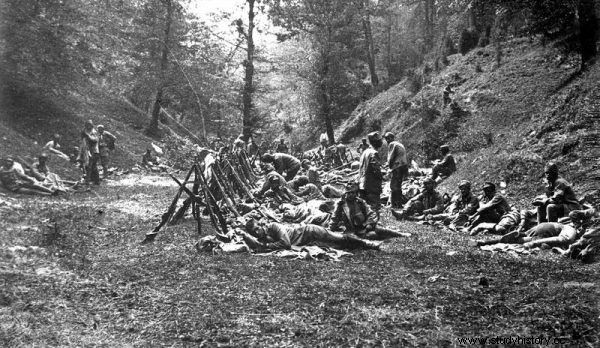
Any place to rest is good. Shooters camping in the woods.
After a day of hiking with a backpack and a rifle, it's time to rest. Soldiers on the trail cannot count on comfortable mattresses. They spend the night wherever they go - in schools, fire stations, in barns, and sometimes just on the road or on the pavement. Their own backpack must be enough for a pillow, and they cover themselves with whatever you have. They can only dream about sleeping bags and blankets. The Austrians did not deliver them.
Sometimes there were days free from marching. Back then, the shooters used the local submarines most often. Polish soldiers arriving in the territories under Russian rule were greeted in various ways. Most often, however, the reactions were far from enthusiastic.
In every town of Congress Poland, entering Sagittarius met silence and a rather sharp smell of fear. Sometimes a handful of "madmen" greeted, most of them already involved in independence work. ("Calendar ...")
One can therefore guess how voluntary the submarines were used by the shooters. When a few uniformed men appear on your doorstep and ask for a lift, you don't ask about your nationality and charge. You harness your horse, take your whip, say goodbye, and hope they will let them come back with the horse and cart. Or come back at all.
Heat, fatigue and non-steel nerves
The beginning of August 1914 was dry and hot, which was a pain for the marching troops. Soldiers, no matter what their rank, could forget about polished shoes and clean clothes. Dust was everywhere. The heat was so unbearable that day by day more and more young people burdened with a rifle and equipment, sat down for a moment in the ditch and did not have the strength to get up.
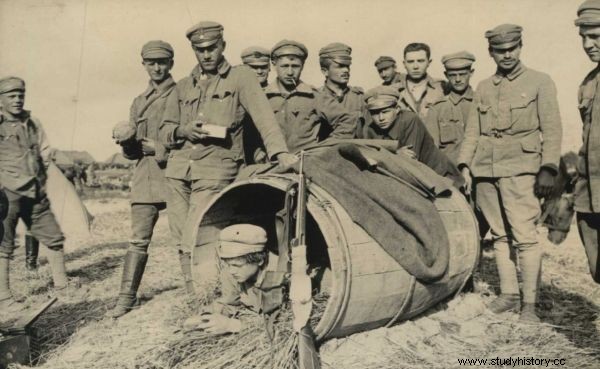
And when finally there was a moment to rest, it was best to rest in…. barrel? The photo shows the legionnaires of the 1st Brigade.
When the soldiers finally take a rest, they realize that an enemy is lurking somewhere. The shooter Wilczyński hints about it in an interesting way.
We are awakened by heavy shooting at night. We hear bullets whistling behind the wall of our barn. We immediately realize that these are shots on our part. We await an answer from the other side, but it does not happen, so we calm down and, not disturbed by the alarm, we go back to sleep.
Later in the diary we learn where the night shooting came from. The dark night, fatigue, and the closeness of the enemy severely strained the nerves of the soldiers on guard. When they heard a rustling in the dark, it immediately seemed to them to be at least a squadron of Cossacks, so they opened fire.
Meanwhile, the two most peacefully grazing farm horses in the world fell victim to the unforgiving and terrified soldiers. One was shot and the other was wounded.
This jumble was the first truly Polish army in many years, and it lacked only one thing - energy, faith and enthusiasm. It is surprising that they succeeded!
